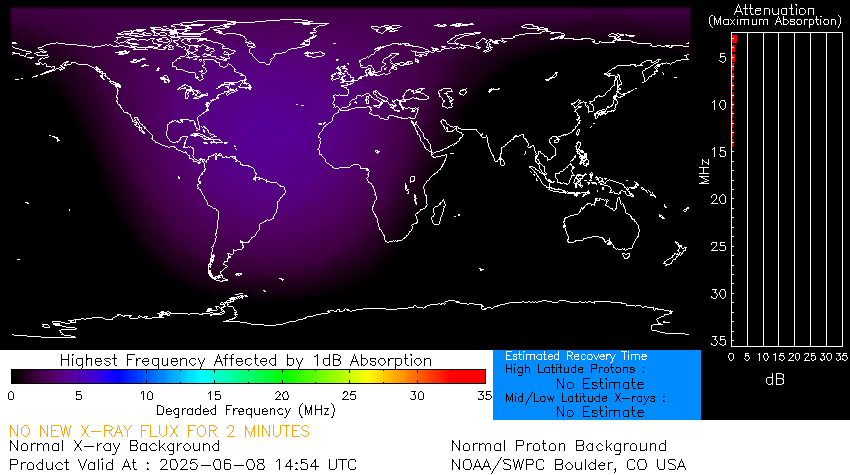Primary aurorae detection plotter, monitors Greystones to NRTF Grindavik (TFK/NRK, Iceland) as well as NAA Cutler (Maine, USA) VLF/LF radio transmitters' amplitudes. Being responsive to auroral ionospheric disturbances these three graphs serves as an indicator of a potential ongoing aurora and its intensity. In contrast to plotters 2/3, this plotter is mostly utilised between local sunset and sunrise, however it is still adequate for daytime sun flares' monitoring. Archive recordings of the graphs are available in our Plotter Archive section. A guide on how to read Plotter 1 is in our User Articles section.
Plotter's legend: NAA 24.00 kHz / TFK 37.50 kHz / NRK 57.40 kHz, timescale is in UTC
Plotter 2: Solar flares' detection plotter, monitors French path, HWU and FTA VLF radio transmitters. Due to ionosphere properities, this plotter can generally be used during daylight hours. Night time operation is heavily affected by mixture of radio propagation modes.
Plotter's legend: HWU 18.30 kHz, 21.75 kHz & 22.60 kHz / FTA 20.90 kHz, timescale is in UTC
Plotter 3: Solar flares' detection plotter, monitors French path - FUG, FTA and FUE LF radio transmitters. Similar to Plotter 2, this plotter is to be used during daytime hours.
Spectrum and waterfall grabber of Plotter 3 - covers 60 - 67kHz frequency range and updates every 5 minutes, click browser's Refresh button to update
Plotter's legend: FUG 62.60 kHz / FTA 63.85 kHz / FUE 65.80 kHz, timescale is in UTC
Plotter 4: Solar flares' detection plotter, monitors Italian path, Greystones to Sardinia (ICV) and Sicily (NSY) VLF/LF radio transmitters. Similar to Plotters 2 and 3, this plotter is to be used during daytime hours.
Plotter's legend: ICV 20.27 kHz / NSY 45.90 kHz, timescale is in UTC
Plotter 5: Solar flares' detection plotter, monitors Greystones to Norway (JXN), Germany (DHO38) and Scotland (GYW1) VLF/LF radio transmitters. Similar to Plotters 2-4, this plotter is to be used during daytime hours.
Plotter's legend: JXN 16.40 kHz / DHO38 23.40 kHz / GYW1 51.95 kHz, timescale is in UTC
D-layer Absorption Prediction map addresses the impact of the solar X-ray flux on HF radio communication.

Geographical locations of the monitored radio transmitters.

Plotter 1:
NAA 24.00 kHz - US Navy, Cutler, Maine, USA - 4.430 km
TFK 37.50 kHz - US Navy, NRTF Grindavik, ICELAND - 1.510 km
NRK 57.40 kHz - US Navy, NRTF Grindavik, ICELAND - 1.510 km
Plotter 2:
HWU 18.30 kHz - French Navy, Rosnay, FRANCE - 885 km
FTA 20.90 kHz - French Navy, Sainte-Assise, FRANCE - 790 km
HWU 21.75 kHz - French Navy, Rosnay, FRANCE - 885 km
HWU 22.60 kHz - French Navy, Rosnay, FRANCE - 885 km
Plotter 3:
FUG 62.60 kHz - French Navy, La Régine, FRANCE - 1.240 km
FTA 63.85 kHz - French Navy, Sainte-Assise, FRANCE - 790 km
FUE 65.80 kHz - French Navy, Kerlouan, FRANCE - 515 km
Plotter 4:
ICV 20.27 kHz - Italian Navy, Isola di Tavolara, ITALY - 1.800 km
NSY 45.90 kHz - US Navy, Niscemi, ITALY - 2.380 km
Plotter 5:
JXN 16.40 kHz - Norvegian Navy, Gildeskål/Novika, NORWAY- 1.875 km
DHO38 23.40 kHz - German Navy, Rhauderfehn Marinefunksendestelle, GERMANY- 910 km
GYW1 51.95 kHz - UK Navy, Crimond, Scotland, UK - 560 km
The plotters are clickable and opens up in a new window each for better vewing experience. The plotters updates every 30 seconds, just click your browser's Refresh button to see a change. You can find the detailed description of technology behind the plots in our Technical section.
In the Plotter Archive section you will find our selected, historical graphs of interest.
Please note - sometimes you can find the plotter appears stuck and not updating for some time. This is a technical issue where manual services' restart is required. Just come back later to check again.




